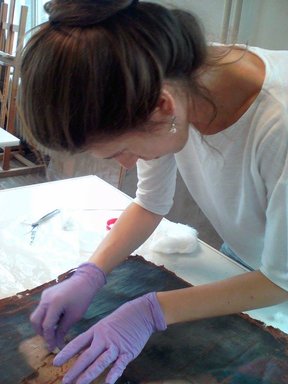MISSION
Primum non nocere!
First of all, I'm trying to understand how a piece of art has changed over time. Beginning with technique and technology and ending with recent conservation, due to the normal ageing process, past interventions, accidents and storage conditions each of these factors affects the artwork's state of preservation. My main aim is to protect and preserve piece of art with the highest respect. My work philosophy is to use my knowledge and experience to dedicate it to the conservation/restoration process.
The less invasive treatment is a more efficient treatment.
I examine every case closely, explaining and planning
five steps ahead.

WORK PROCESS
1. Send me a message via the contact form or an email. The best with a photo/photos.
2. I will respond by setting up
a meeting.
3. We will meet in person with
a piece of art.
4. Next - consultation.
5. Pre-examination.
6. I will send you a proposal.
7. I will start the conservation/restoration process
if you accept the proposal.
- wood panel consolidation
- surface cleaning
- removing old, uneven varnish layer
- repair of wooden supports
- filled wood losses
- new varnishing
- repair tears and holes
- surface cleaning - removing surface dirt and contamination
- varnishing
- frame restoration
- improved loose and unstable canvas
- surface cleaning
- tear damage restored
- removing old and discoloured, blooming varnish layer
- frame restoration
Mid-term project in
Universidad La Laguna Tenerife,
Faculdad de Bellas Artes
"Retrato de hombre"
under examination
Development of restoration strategy based on:
- technical analysis
- condition reporting
- technical photography: visible light, UV light, raking light
- creating a map of damage
MURAL PAINTINGS
& STONE
Lviv, Ukraine
Conservation and restoration of 18th-century
frescos in the Orthodox church.
Deep water deterioration caused by leaky roof. The wall, mortar layer and paint layer are exposed to high salinity and high humidity for a long time.
Step 1 - conservation:
- stabilising mortar layer
- stabilising the paint layer
- mural painting consolidation by inside wall injections
The main subject of my MA thesis is a mural painting by artist Władysław Trebunia Tutka entitled „The Highlander Wedding”. The work was completed in 1971 as a frieze - under the ceiling decoration in the building of the worker cooperative "Budimet" in Suche, in Poronin municipality.
The building was constructed in 1935 and until the 1990s its main purpose was of a social and administrative nature. It also hosted the regional dance and music group "Harnasie", in which Władysław was also involved as an amateur musician. After the political transformation in Poland, the building was abandoned and as a result, fell into gradual disrepair. After Wladyslaw passed away in 2012, the local community began activities with the goal of preserving the endangered murals. After the report of a professional building inspector, it was concluded that the building could not be salvaged and had to make space for a new development. In order to save the murals, it was decided to undergo a murals transfer procedure. The involvement of the Poronin municipality contributed to the construction of a new communal building on the site of the former "Budimet" building.
Practical work began in 2019 and lasted until the end of 2020. The scope of the work included full technical conservation and restoration of the transferred mural. In 2019, the following was performed: delamination and transfer of the wall painting in order to preserve the work of art. Then in 2020 the conservation and restoration of the painting was started, with the ultimate aim of reinstalling the „The Highlander Wedding” in the newly constructed communal building in Suche.
Conservation of contemporary mural „The Highlander Wedding” by Władysław Trebunia Tutka.
Technical and technological challenges concerning the transfer and restoration of contemporary murals.
Thesis supervisor: Dorota Białek-Kostecka Ph. D.
The thesis contains cultural anthropological information detailing the traditions and rituals of the inhabitants of Podhale region. The theoretical part includes descriptions of physicochemical research and further analyses and summarises the findings. This research is aimed at furthering understanding of the context, techniques and structure of the contemporary mural in question. As part of preliminary research, an in-depth interview was conducted with the artist's daughter.
The result of the concerted efforts of the community, municipality, contractors, architects and restorers was the return of the transferred murals to the newly constructed communal centre: the Poronin Cultural Centre of Podhale in Suche. Mural transfer: „The Highlander Wedding” has the dimensions: 100 cm x 930 cm and after consultation with the architect it was installed in the main hall of the building.
Transfer of contemporary mural painting - mixed media technique on the wall.
During the MA thesis research, a number of studies were carried out:
- condition reports
- technical photography
- pigment analysis
- cross-section analysis
- art historical analysis
- historic context
The results showed unique materials - unusual and complex - were used on mural surfaces. The artwork required special treatment and research focused on strategy for care and preservation.
A comprehensive approach accomplished successful conservation and restoration.
This work was completed under the guidance of the Department of Conservation and Restoration of Mural Paintings by the Mural Painting Transfer workshop in Kraków.
Ceramic mosaic transfer.
Transfer of murals
as a method of preserving monuments. Saving contemporary art for future generations.
Conservation and restoration of sandstone sculpture from the early 20th century. Fasade of the historical building in the city centre of Kraków.
Internship on archaeological sites. Remnants of
a medieval Maison with their environment in Mirosławiec (West Pomeranian Voivodeship,
north-western Poland).
What allows us to survive?
What allows us to remain ourselves is our poetry, our art, our beauty.
- improved weakened joints
- improved modern furniture with unstable features
- replaced missing brassware features
- replaced missing locks system
- structural conservation
FURNITURE
RESTORATION
Restoration of modern, late art deco dressoir adding contemporary design to suit client's personal taste for interior design.
COPYRIGHT © ALL RIGHTS RESERVED